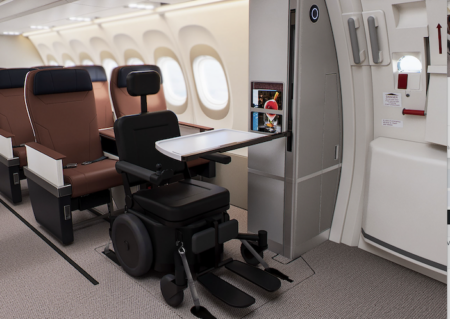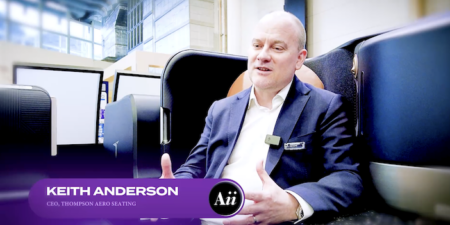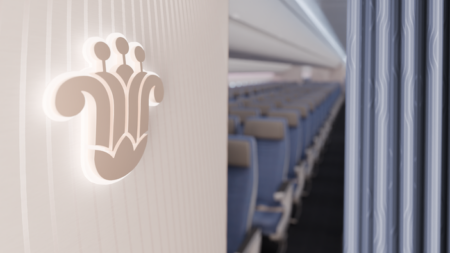Above: The endbays of the Lift seat have been carefully designed to allow easy ingress and egress. Picture courtesy of Adam Gavine
To enter the aircraft seating market with a statement of intent to ‘change the way the industry thinks about tourist-class seats’ is a bold approach, but that is how Lift, a new division of EnCore, has pitched its entry into the market.
With a little inspiration from the world of office furniture and some design classics such as the Eames Eiffel chair, Lift and its design consultant, PearsonLloyd (a company with a great deal of experience in office and residential furniture, as well as Lufthansa’s bespoke business class seat), decided that simplicity was key to creating a comfortable experience in economy. The Eiffel, as with many other plastic design classics, does not rely on bulky padding to achieve comfort, so Lift and PearsonLloyd decided it was also not necessary for an aircraft seat. Instead a sculpted seatpan and ergonomic seatback provide comfort with minimal padding, as well as a simpler appearance.
Where many seat manufacturers shroud the structure of a seat in plastics to achieve a passenger-friendly aesthetic, Lift has left those materials exposed. Carbon fiber is not usually a desirable finish unless you wish to achieve a race car aesthetic, but in these seatbacks it feels minimal and simple, with a sense of honesty about what the seat is intended to achieve.
Above: Developmental test seat, simple, strong and elegant
“A lot of the work that goes into the design process usually gets covered up, which is a shame. It’s our goal to celebrate the beauty of materials and the honesty with which they are applied. This also has advantages for parts count, weight, maintainability and reliability,” said Luke Pearson, co-founder of PearsonLloyd. The weight in question is 10kg per pax place in a standard baseline triple.
Something that is covered up in the new design is the single recline (0-3in) actuator under the seat, which can be accessed by crew using a quick-release system. The central position of the actuator minimizes torque loads, which helps lengthen the service life of the unit, and the backrest is also a quick release item as it is a separate shell that can be swiftly unhooked once unlocked.
Details
Another example of the minimal design philosophy is the tray table, with its exposed machined aluminum arms – another choice born of engineering, but which whispers its technical function and feels premium. The unique arms allow the stowed table to sit flush with the seatback, and also create a little extra knee room. The table is deployed by rotating the latch – a nice detail that marries aesthetics with head impact considerations – with the table’s chamfered edges adding to the ‘soft’ feel.
Sitting flush just above the tray table is a simple aluminum flap that conceals a few features, including coat hook, an optional USB port and – when you pull back the nicely damped flap – a simple slot for holding a PED, with a groove to the side to neatly route a cable. Airlines providing their own PEDs for IFE may appreciate the further option of a clip function for extra security.
Above: Simple pleasures. The lip above the tray table conceals many comfort features. Picture courtesy of Adam Gavine
There is a real sense of attention to detail and craftsmanship in the seat design, with its various features creating visual interest without feeling alien from seating products used on terra firma. Crucially, while aspects such as weight, maintainability and durability have been considered, it feels like another key aspect has been considered: the passenger experience.
Ready for Lift-off?
So what stage is the seat currently at? Lift says the seat is production-ready. The company has conducted reliability tests, FMEA tests and dynamic sled tests, and is aiming to certify the seat under TSO C127B by Q1 2016.
As Tom McFarland, CEO at EnCore and Lift, told us at the private seat reveal at Aircraft Interiors Expo, “Lift is for sale today. It will be certified and ready by Q1 2016, and we are now in the process of looking for a customer and going through engineering certification. We’ve done all the early developmental tests and crash tests, etc, and this year we move to certification, with or without a customer – but hopefully with. We’ll be certifying the design with all options accounted for, so from then on, ordering the seat can just be a matter of selecting just trim and finish, which helps with delivering on time.”
We tried out the seat demonstrator in a B737/A320 configuration at a 30in pitch and with an 18in seat width. It certainly proved comfortable enough for a few minutes, and we expect it will also prove comfortable for short- to mid-haul routes. For short-haul routes, operators may opt for a 17in seat width and the minimum 29in pitch, while 18in at a 33in pitch may work better for mid-haul.
But what if an airline was looking at Lift for long-haul routes? McFarlane is prepared, stating, “If a B777 operator came along, we wouldn’t start again – this would be the base model.” Features and options can easily be added, including a rather neat seatback install option, a headrest option and an articulation option.
Above: The seat pan is sculpted for comfort and efficiency
So what of Lift itself? The company has instant credibility given that parent company EnCore is well established in the market, with engineering and production expertise in various cabin product lines including galleys, stowage bins, sidewalls, lavs and ceiling panels, as well as expertise in advanced composites.
EnCore’s move into seating is thus a logical progression, but with so many competitors in the economy seating segment, is there space for a new entrant? CEO McFarland is confident: “Between Airbus and Boeing we see quite a need for additional capacity, which gives us an opportunity to penetrate the market. We know airline customers are ready because we do all sorts of interiors work.
“While this is our first aircraft seat, we have pretty solid connections with airframe manufacturers and airlines, so I don’t think getting work will be a problem. At [Aircraft Interiors Expo] there are a lot of seat companies, but viable companies that can certify and produce? That field is a lot narrower, in my opinion. A lot of seats we see are creative, but not typically airworthy. This seat, when you see it installed, will look just like this. It is not a show seat, it is a production seat.”
The difference between Lift and many competitors, says McFarlane, is in the design: “We’ve had everyone from leasing companies to major airlines looking at the seat. Leasing companies want to know the weight and price, while high-end airlines like the styling. But Lift works for either, as it is a lightweight and affordable product, but with a distinct feel. We think it is adaptable to all environments. Everyone wants reliability, maintainability and durability – the differentiator is the design focus. Anybody can make a food tray arm, but not many will make it of visual interest.”
April 29, 2015. Adam Gavine




